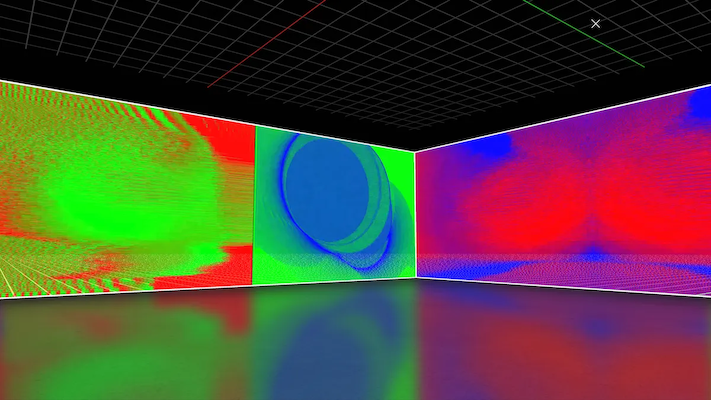Join Our Telegram channel to stay up to date on breaking news coverage
Niall Dailly, also known as DJ Plus One, an electronic artist and former world champion turntablist, developed interactive visual experiences for his new album “Metamorphic” in part as a result of the creative possibilities offered by Web3. And there’s a special twist: NFT holders have the last say over whether the public can freely access that media.
When the COVID-19 epidemic broke out, Dailly—a former member of the Scratch Perverts and Jack Beats—started looking into NFT prospects. The Scottish musician’s live engagements were canceled, and as a result, he found himself with a lot more free time.
Dailly started thinking about how to make something new and significant around his solo album project “Metamorphic,” which will be published under the name DAILLY, after exploring the Web3 area and taking inspiration from early audiovisual NFT pioneers like Deafbeef. He said that the idea first came to him when a friend encouraged him to “do anything you want” with Web3 technology.
Introducing https://t.co/zd3kQwXwXJ
For the last 9 months, we've worked with renowned artist DAILLY to create @metamorphic_gg – a first-of-its-kind 3D/VR music album journey that pushes the boundaries of installation art, experience, and the album format itself.
— BeetsDAO (📼,📼) ⌐◨-◨ (@BeetsDAO) January 5, 2023
Dailly wanted his new album’s visual narrative to be more than just a “very stunning visualizer,” in his words, so he set out to make it. However, creating something within an already-existing metaverse game universe didn’t feel right. It has to blend in with the music while yet being distinctive enough to try to get the attention of fans of contemporary music.
People see things on their phones when they play music, and you kind of have to preach pretty far these days. People don’t really pay attention.
Working with 3D artist Logan Gomez and art director Jeff Metal, Dailly scanned actual environments using Lidar technology on an iPhone, then used the information to represent locations in East London as a tribute to the growth of the electronic music scene. They created visual artwork to go along with Dailly’s glitchy electronic soundscapes using both manual and generative alteration techniques.
Users can explore each interactive place in a web browser on a sufficiently powerful computer or device and take in the audiovisual picture. Additionally, you can enjoy it using a VR headset like the Meta Quest 2 or Quest Pro.
BeetsDAO (the group behind the NFT science fiction book project Lost Children of Andromeda and the Snoop Dogg x Nyan Cat NFT collaboration) and the art platform Async Art will sell Metamorphic’s interactive environments in an exclusive Ethereum NFT drop this month, with 10 renditions of the album totaling each featuring the 10 songs.
Each of the 100 NFTs will cost one ETH ($1,260 at the time of writing) and point to a different web-based experience. (An NFT is a blockchain-based token that establishes ownership of a one-of-a-kind item, such as digital media such as artwork, music files, and collectibles; NFTs can also act as an access pass to both virtual experiences and actual events, and they give users the opportunity to vote on community and project decisions.)
There will likely be a rather small number of owners in this group, so the drop size won’t be the main deciding factor. This is due to the fact that prospective customers—whether they are private persons or NFT-collecting DAOs—must do a video chat interview with Dailly before he authorizes anyone to mint the “Metamorphic” NFT albums.
After all, they have been entrusted with making a significant choice about the fate of his creation.
A moral conundrum
When “Metamorphic” debuts, anyone can access the interactive web-based locations through the official website, independent of NFT ownership. Users of the public version of the experience are free to explore the 3D settings as much as they like for at least six months online.
After that, it will be up to the proprietors of NFT albums to decide if such experimental music-fueled universes are still accessible online. Daily presents it as an ethical conundrum to match the aesthetic and atmosphere.
Should everyone have access to and be able to purchase work that is held by a small group of people? Or will they decide to keep the artwork private beyond that first window and treasure it for themselves? Within this context, the idea and potential advantages of scarcity can be interpreted in a variety of ways, so NFT owners will need to weigh their options before voting.
Do you think that [“Metamorphic’s”] existence in reality is advantageous to you or not? Do you have the self-centeredness to believe, “Actually no, I want it just for me?,” Dailly asks. Or are you perhaps as smart as to believe that if I put it out indefinitely, my NFT will actually become more and more valuable the more well-known this becomes?
According to Dailly, the dynamic was influenced by the conventional art world, where privately held artwork may be shown to the public in a gallery for a few months before disappearing from view. He wanted purchasers to be attracted to the “Metamorphic” experiences and have a real voice in the subject, so that they wouldn’t only ever be experienced by a small number of owners.
Dailly will personally screen potential NFT album purchasers, but this does not give him complete influence over the decision-maker. If not all 10 albums are purchased in the first round of sales, the remaining tracks will be offered for sale to the general public. Additionally, album purchasers have the option of “breaking” an album and reselling individual NFT tracks.
The new beginning is here… pic.twitter.com/LxTUQqKmnr
— Dailly (@D_A_I_L_L_Y) November 28, 2022
Initial album purchasers will be given a unique token with governance rights, which they are free to maintain even if they decide to sell off individual tunes. Collectors who purchase all 10 individual tracks can later, if any are still available, claim their own album token with the same privileges; there will only ever be 10 album tokens, resulting in 10 total votes for the project’s future.
The NFT project’s smart contract includes a feature that allows users to disable public access to the website with the “Metamorphic” experiences. (The code that drives autonomous decentralized apps and NFT projects is contained in a smart contract.)
After the initial six months, each owner of an album token can use the destroyPublic() method to call a vote. If there is a quorum and a majority vote, the “Metamorphic” website will be permanently changed to a token-gated version that can only be seen by NFT holders.
In the end, Dailly asserts that he is content with the notion that holders will control the course of the public experience, even if they are not the people he chooses to oversee the undertaking.
You can’t sell someone something and then claim, “Yeah, it’s free forever,” he asserts.
A Personal Endeavor
It’s an experiment, even if Dailly and his BeetsDAO partners acknowledge that it will probably end up costing money in the end. The album’s creation and graphic accompaniment revision required a lot of time and money, and the decline in NFT demand and cryptocurrency prices is only moderate in scale.
Later on, the “Metamorphic” music will also be made available to a wider audience, including through a second NFT drop that will pair album audio with a special still image created from the Lidar-driven footage. No ETA has been given, however pricing is anticipated to be more geared toward the mass market and have a cost comparable to a CD box set.
According to Dailly, “I personally need something that’s nearly like merch table costs” or “poster at the gallery prices.” The “phase two” conversation essentially began because “I need something to make this sit good with me ethically.”
Dailly characterizes the initial experience drop as more of an innovative art piece than a corporate move, even with another NFT step ahead. It serves as both a proof-of-concept for what is achievable with Web3 media and community governance from a different perspective and a remark on the controversy surrounding the public exhibition vs. private ownership of art.
He adds that the unrestricted technology possibilities surrounding Web3 only increase his ardor for the future of music in the area, saying
At a certain point in life, when you’re older and truly going for something you feel passionately about—you do these things. I get quite enthusiastic when people use the technology here to do other things.
Related
- For additional revenue streams, NFT developers diversify into real-world assets
- Best NFTs to Buy and How to Buy NFTs
- Best Crypto Winter Tokens to Invest In for High Gains
Join Our Telegram channel to stay up to date on breaking news coverage



